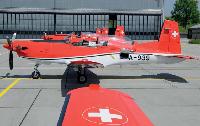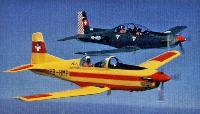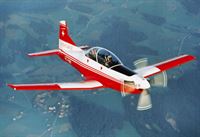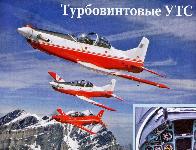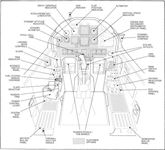
Варианты
- Pilatus - P-3 - 1953 - Швейцария
- Pilatus - PC-7 Turbo Trainer - 1966 - Швейцария
Pilatus PC-7 Turbo Trainer
PC-7 был создан на базе самолета Pilatus P-3, разработанного еще в 1950-е годы и оснащенного поршневым двигателем. Прототип PC-7 оснащался ТВД Pratt & Whitney Canada PT6A-20 мощностью 550 л.с. и был облетан в апреле 1966 года. Однако после происшествия в испытательном полете - пилоту пришлось выполнять вынужденную посадку, проект "положили на полку" до 1973 года, когда P-3 был модифицирован и получил двигатель PT6A-25 номинальной мощностью 650 л. с., пониженной до 550 л. с. Самолет был облетан 12 мая 1975 года, но затем подвергся существенной доработке для получения максимальной выгоды от применения более мощного двигателя. От прототипа в Turbo Trainer мало уже что осталось.
Вместе с компанией "Dornier" специалисты "Pilatus" разработали совершенно новое односегментное крыло с топливными баками в передней его части - перед единственным лонжероном. "Dornier" также разработала совершенно новое шасси - ввиду того, что максимальная взлетная масса машины выросла на 57%. Впоследствии доработке подверглись задняя часть фюзеляжа и хвостовое оперение. Эти, а также иные изменения, среди которых можно отметить каплевидный фонарь негерметизированной кабины, были внедрены на первом серийном PC-7, который впервые поднялся в воздух 18 августа 1978 года в Стансе.
Первые поставки были осуществлены ВВС Мьянмы, ставшим стартовым заказчиком после выдачи в начале 1979 года самолету сертификата типа американской Федеральной авиационной администрацией. PC-7 в то время имел только одного конкурента - самолет Beech T-34C, поэтому продажи на экспорт шли интенсивно, а в июне 1981 года ВВС Швейцарии разместили заказ на 40 самолетов. Для подготовки летчиков применению вооружения на шести подкрыльевых узлах подвески можно размещать различные средства поражения общей массой до 1040 кг. Считается, что PC-7 использовался в боевых действиях в ходе ирано-иракской войны обеими сторонами. В 1985 году компания "Pilatus" предложила своим клиентам модернизацию самолета путем установки двух катапультных кресел Martin-Baker CH.Mk 15A, и первым заказчиком такой модернизации стал Иран.
ТАКТИКО-ТЕХНИЧЕСКИЕ ХАРАКТЕРИСТИКИ
Pilatus PC-7 Turbo Trainer
Тип: УТС начальной и повышенной летной подготовки
Силовая установка: один ТВД Pratt & Whitney Canada PT6A-25A номинальной мощностью 650 л. с. (485 кВт), пониженной до 550 л. с. (410 кВт)
Летные характеристики: максимальная крейсерская скорость на высоте 6095 м - 412 км/ч; максимальная скороподъемность на уровне моря 655 м/мин; практический потолок 10 060 м; дальность полета 1200 км
Масса: пустого в базовом варианте 1330 кг; максимальная взлетная 2700 кг
Размеры: размах крыла 10,40 м; длина 9,78 м; высота 3,21 м; площадь крыла 16,60 м2
- Описание
Фотографии
-
Мировая Авиация 214
Регистрационный номер: FAB-467 [2] Боливия получила 26 самолетов PC-7, которые использовала в качестве УТС. Данная машина эксплуатировалась в боливийской пилотажной группе, находившейся на авиабазе Санта-Роза.
-
Мировая Авиация 241
ВВС Мексики эксплуатируют PC-7 (на рисунке) и PC-9M в качестве учебно-тренировочных и легких штурмовиков. 65 самолетов PC-7 распределены примерно поровну между учебными и "противоповстанческими" эскадрильями. Вооруженные PC-7 использовались в 1994 году во время конфликта в провинции Чьяпас против сепаратистов.
-
АвиаМастер 2005-04 / А.Харук - Современная "индейская война" /Горячая точка/
"Пилатусы" PC-7 мексиканских ВВС в разных вариантах камуфляжа.
-
Air International 1978-09 / R.Baybrook - Combat Aircraft Spectrum
Регистрационный номер: HB-HOZ [5] The Pilatus PC-7 prototype as modified to represent the production configuration, now ordered by Burma, Bolivia and Mexico;
-
Air International 1981-09 / J.Fricker - Pilatus PC-7
The first of the two production PC-7s used for Flugwaffe evaluation; both are now to be retained as part of the 40-aircraft order recently confirmed. The first aircraft was flown by John Fricker for the accompanying pilot's assessment.
-
Air International 1981-09 / J.Fricker - Pilatus PC-7
Регистрационный номер: A-903 [4] The second of the two production PC-7s used for Flugwaffe evaluation; both are now to be retained as part of the 40-aircraft order recently confirmed.
-
Jane's All the World Aircraft 1980 / Encyclopedia of Aviation - Aircraft A-Z - v5
Регистрационный номер: HB-HAO [2] Pilatus PC-7 Turbo-Trainers.
-
Air International 2016-11 / B.Fischer - Swiss Training /Military/
Регистрационный номер: A-917 The culmination of pilot selection for the Schweizer Luftwaffe is a six-week stage flying 13 missions on the PC-7.
-
Air International 2007-08 / News: Headline, Military, Civil, Airshow, Accidents
Регистрационный номер: A-937 Upgrade of Swiss Air Force Pilatus PC-7 Turbo Trainers with a new glass cockpit, GPS, auto pilot and second VHF radio is progressing well. The first two aircraft to be completed, including A-937 seen here, were handed-over last November and, as can be seen, a new colour scheme is also being applied. By the end of this year a total of 18 aircraft will have been modernised to the new NCPC-7 (New Cockpit PC-7) standard, whilst approval is being sought for a further ten aircraft to be upgraded.
-
Air International 2016-11 / B.Fischer - Swiss Training /Military/
Регистрационный номер: A-939 Students streamed for fixed-wing training spend 200 flight hours and 20 simulator hours on the PC-7 before moving on to the PC-21.
-
Air International 2016-11 / B.Fischer - Swiss Training /Military/
Each year, the Schweizer Luftwaffe screens 350 candidates, around 250 of whom will attend SPHAIR.
-
Авиация и Космонавтика 2018-12 / Д.Пичугин, А.Бельтюков - Эскадрилья Fliegerstaffel 11
Регистрационный номер: A-919 -
Авиация и Космонавтика 2018-10 / Е.Казеннов - Авиашоу "RIAT-2018"
Другие самолёты на фотографии: McDonnell Douglas F/A-18C Hornet - США - 1986
-
Мировая Авиация 241
Регистрационный номер: HB-HMP [3] В сравнении с PC-7 (на переднем плане) PC-9 имеет большие размеры и массу, а также более мощную силовую установку. Главное отличие - приподнятое заднее кресло инструктора.
Другие самолёты на фотографии: Pilatus PC-9 - Швейцария - 1984
-
Air Pictorial 1991-11 / M.Ashley - La Patrouille ECCO AP exclusive interview
The Patrouille team leader, Jacques Bothelin, prepares his aircraft for a fine flying display.
-
Air Pictorial 1991-11 / M.Ashley - La Patrouille ECCO AP exclusive interview
The pilots of the 1991 Patrouille ECCO pictured beside their aircraft prior to their display at Bournemouth. From the left: Jacques Bothelin, Michel Hugo Veran, Pascal Aubert and Jean-Louis Jordano.
-
Air Pictorial 1991-11 / M.Ashley - La Patrouille ECCO AP exclusive interview
The green grass of Badminton's private strip complements two of La Patrouille's PC-7s as they accelerate for take-off.
-
Air Pictorial 1991-11 / M.Ashley - La Patrouille ECCO AP exclusive interview
The four Pilatus PC-7s of La Patrouille ECCO in action against the azure blue skies over the South Coast.
-
Air Pictorial 1991-11 / M.Ashley - La Patrouille ECCO AP exclusive interview
Making smoke over the Bournemouth skies at this year's airshow
-
Air Pictorial 1991-11 / M.Ashley - La Patrouille ECCO AP exclusive interview
Регистрационный номер: HB-HMA [2], HB-HMB [3], HB-HMP [3] La Patrouille ECCO in its unique vertical stack formation. Not even the compressed effect of a telephoto lens belies how close the PC-7s fly.
-
Air Pictorial 1991-11 / M.Ashley - La Patrouille ECCO AP exclusive interview
Регистрационный номер: HB-HMB [3] Two of the team's PC-7s perform their dramatic Roulette cross-over at Badminton
-
Мировая Авиация 214
Регистрационный номер: HB-HMA [2], HB-HMB [3], HB-HMC В 1980-х годах для компании "Pilatus" лучшей рекламой стали выступления швейцарской гражданской пилотажной группы "Team Martini".
-
Air Pictorial 1991-11 / M.Ashley - La Patrouille ECCO AP exclusive interview
Forerunners to La Patrouille ECCO the three PC-7s flew in the colours of Martini Racing, seen here taking off from Middle Wallop for the International Air Show '90.
-
Авиация и Космонавтика 2012-11
Авиашоу на авиабазе Мальмен, Швеция. Пилатус PC-7
-
Air Pictorial 1999-10 / Pilatus: Designing for 60 years
Регистрационный номер: 3H-FB, 3H-FD, 3H-FE [2], 3H-FF Four of 16 PC-7s in Austrian AF service.
-
Авиация и Космонавтика 2017-11 / В.Морозов - Авиация Австрии: 1919-2017гг. (2)
Регистрационный номер: 3H-FE [2] УТС Пилатус PC-7
-
Мировая Авиация 241
Регистрационный номер: 3H-FG ВВС Австрии получили с 1983 года 16 самолетов PC-7 "Viper" и используют их в качестве учебных и "противоповстанческих". Данный самолет получил юбилейную окраску в честь 20-летия эксплуатации PC-7 в Австрии.
-
Air International 2020-11 / S.van Roij - Dutch masters
Регистрационный номер: L-08 The PC-7 in its original yellow colours preparing to land at Gilze-Rijen in 2005
-
Мировая Авиация 214
Регистрационный номер: L-02 [2] Среди заказчиков PC-7 были Голландия (на фотографии), Абу-Даби (ОАЭ), Ангола, Австрия, Боливия, Мьянма, Чад, Чили, Франция, Гватемала, Иран, Ирак, Малайзия, Мексика, Нигерия, Швейцария и Суринам.
-
Мировая Авиация 241
Регистрационный номер: L-04 Голландские ВВС, начиная с 1989 года, получили 13 самолетов PC-7, которые поступили на вооружение 131-й эскадрильи (авиабаза Вонсдрехт). Вначале самолеты несли такую яркую желто-красную окраску, но сегодня они окрашены в черный цвет.
-
Air International 2020-11 / S.van Roij - Dutch masters
Регистрационный номер: L-13 [2] The special scheme on this PC-7 trainer marked the 131 EMVO Squadron's 30th anniversary with Royal Netherlands Air Force in 2018.
-
Air International 2018-09 / Airscene
Регистрационный номер: L-13 [2] Koninklijke Luchtmacht (Royal Netherlands Air Force) Pilatus PC-7 Turbo Trainer L-13 (c/n 612) received special tail markings in July 2018 to celebrate 30 years of 131 EMVO Squadron. The Elementaire Militaire Vlieger Opleiding (EMVO, elementary military pilot training) commenced pilot training at Woensdrecht Air Base in August 1988 and saw its first four of 13 PC-7s entering service on February 8, 1989. The Dutch PC-7s are currently being modified by Pilatus in Switzerland to continue in service until at least 2025.
-
Air International 2013-12 / News
Регистрационный номер: L-02 [2], L-11 Pilatus PC-7 Turbo Trainer L-02 (c/n 539, ex HB-HLV) received special markings for the 25th anniversary of 131 EMVO (Elementaire Militaire Vlieger Opleiding, elementary military pilot training) Squadron, celebrated on October 10, 2013 at its home base, Woensdrecht AB. The unit took delivery of ten PC-7s (L-01 to L-10, c/n 638 to 647) between January 26 and September 14, 1989; a further three (L-11 to L-13, c/n 610 to 612) were added on July 11, 1997, in response to a need for more pilots. The aircraft were repainted from their original yellow, red and white colours to the current black with yellow in 2005/2006.
-
Air International 2020-11 / S.van Roij - Dutch masters
Регистрационный номер: L-07 A student pilot checks Gilze-Rijen's CTR (controlled traffic region) during a low approach to the air base
-
Air International 2020-11 / S.van Roij - Dutch masters
Регистрационный номер: L-12 Capt Pieter in front of one of the EMVO squadron's PC-7s at Woensdrecht air base
-
Air International 2017-09 / Airscene
Регистрационный номер: L-01 Upgraded KLU PC-7 L-01 back at Woensdrecht Air Base, after its ferry flight from Stans-Buochs on July 19, 2017.
-
Air International 2020-11 / S.van Roij - Dutch masters
The 131 EMVO Squadron's home is at Woensdrecht, the most southwestern air base in the Netherlands
-
Aeroplane Monthly 1999-12 / M.Oakey, T.Harmsworth - News
Регистрационный номер: N1NG Pilatus PC-7 N1NG, seen at Stans, Switzerland, in May 1999, has returned from the USA for restoration as HB-HMO.
-
Air International 1985-10 / Colour Contrasts at Stans
PC-7s recently ferried to the Islamic Republic of Iran Air Force and which were apparently to receive after arrival national insignia on the fuselage sides both fore and aft of the cockpit.
-
Air International 1985-10 / Colour Contrasts at Stans
Регистрационный номер: HB-HCC Immediately below left is a PC-7 for the Iraqi Air Force, bearing a logo indicating that it is the 100th delivery.
-
Мировая Авиация 157
Регистрационный номер: R-422 Поначалу командование ВВС Анголы не допускало южноафриканцев к полетам на Су-22М-4, доверив ветеранам ВВС ЮАР только PC-7. PC-7 прикрывали вертолеты Ми-17, вели разведку и решали задачи передового авианаводчика.
-
Air International 1981-09 / J.Fricker - Pilatus PC-7
The first customer to sign a firm order for the Turbo Trainer was the air force of Burma, which has to date acquired 17.
-
Air International 1981-09 / J.Fricker - Pilatus PC-7
Three successive contracts have brought the total of PC-7s ordered by Mexico to 55, making this air force the largest user of the Turbo Trainer to date. Initially, aircraft were delivered to Mexico in the "trainer yellow" finish shown (on photo) but later aircraft, now coming off the line at Stans, are camouflaged in shades of green and brown.
-
Air International 1985-10 / Colour Contrasts at Stans
A PC-7 for the Fuerza Aerea Mexicana, a recent repeat customer for this trainer.
-
Air International 1981-09 / J.Fricker - Pilatus PC-7
Three successive contracts have brought the total of PC-7s ordered by Mexico to 55, making this air force the largest user of the Turbo Trainer to date. Initially, aircraft were delivered to Mexico in the "trainer yellow" finish shown but later aircraft, now coming off the line at Stans, are camouflaged in shades of green and brown, as illustrated.
-
Air International 1981-09 / J.Fricker - Pilatus PC-7
The Chilean Navy is one of nine export customers for the PC-7 (not all of which have been named by Pilatus). Ten have been delivered to Chile, and a re-order is likely soon.
-
Air International 1987-10 / ??? - Bolivian Air Power - Seventy Years On
Регистрационный номер: FAB-463 Camouflage finish and a shark's mouth marking suggest that this PC-7 of GAC 34 is used for combat training. The addition of light weaponry to some of the PC-7s is under study by the FAB.
-
Air International 1987-10 / ??? - Bolivian Air Power - Seventy Years On
Регистрационный номер: FAB-467 [2] Strikingly decorated, these Pilatus PC-7s form a demonstration team within GAC 34, the advanced training unit of the FAB at Cochabamba.
-
Air International 2015-05 / E.Calcagno - Tanque /Military/
Primarily trainers but with a secondary attack role, PC-7Us are locally designated AT-92s.
-
Air International 1999-05 / B.Taylor - Military Aircrew Training. What's Next? /Military aviation/ (2)
In its current production form the Pilatus PC-7 Mk II is structurally similar to its more powerful stablemate, the PC-9.
-
Air International 1999-05
The Pilatus PC-7 Mk II M and PC-9M Military Trainers are purpose-designed to comply with the high standards required in the training of future operational jet pilots. The concept includes not only high quality, outstanding reliability, unsurpassed performance and excellent handling characteristics, it also provides a comprehensive training system, integrated logistics and customer support with a full range of ground-based training equipment. With significantly reduced costs and innovative products, Pilatus leads the way in modern turboprop training.
-
Jane's All the World Aircraft 2000 / 2-02 - AIRCRAFT - FIXED-WING - MILITARY/CIVIL
Регистрационный номер: HB-HMR [2] Pilatus PC-7 Mk II M Turbo Trainer prototype/demonstrator (1999)
-
Авиация и Время 2019-06 / П.Нор - Для учебы и не только
Регистрационный номер: HB-HMR [2] Учебно-тренировочный самолет швейцарской компании "Пилатус" PC-7
-
Авиация и Время 2013-02 / А.Хаустов - Aero India-2013
Турбовинтовой УТС Pilatus PC-7 Mk.II - новичок в составе ВВС Индии
-
Air International 2013-03 / News
Регистрационный номер: HB-HCF Pilatus PC-7 Mk II TurboTrainer HB-HCF/P-106 (c/n 695) is the sixth example of the aircraft produced for the Indian Air Force. It is seen at the manufacturer's airfield at Stans, Switzerland, on January 18, 2013.
-
Air International 2013-07 / News
Pilatus PC-7 Mk II P-101 (c/n 690) was the first of its type to arrive at Dundigal, where the trainer was inducted into Indian Air Force service at the end of May 2013.
-
Мировая Авиация 241
ЮАР - стартовый заказчик на PC-7 Mk II. Страна заказала 60 самолетов (местное обозначение "Astra"), которые получила в 1993-2006 годах. Пять самолетов принадлежат пилотажной группе "Silver Falcons".
-
Air International 2012-11 / G.Martin - Africa Aerospace and Defence
State-owned acquisition, support and disposal agency Armscor is offering Pilatus PC-7 Mk II Astra and Cessna 185 aircraft for sale. Approximately 20 PC-7 airframes are surplus to SAAF requirements - out of the 60 purchased in 1993, five were lost due to attrition and 35 are having their avionics upgraded and should be delivered in March 2013. If the PC-7s are not sold (they require engine work and avionics improvements) they may be cannibalised for parts or scrapped.
-
Air International 2008-07 / D.Willis - Military Display Teams /Military/ (2)
Four PC-7s Mk II Astras of the South African Air Force Silver Falcons in echelon port formation over Cape Town.
-
Air International 2012-11 / G.Martin - Africa Aerospace and Defence
One of the stars of AAD 2012 was the South African Air Force's C-47TP 6840 'Gooney Bird', painted in Silver Falcons aerobatic team colours. The aircraft was launched as an official support element to the team just before the show. It performed with the six PC-7 Mk IIs of the Silver Falcons at AAD - its first public appearance in the new colour scheme. The SAAF has 11 C-47s in service.
Другие самолёты на фотографии: Douglas DC-3TP - США - 1951
-
Мировая Авиация 241
Регистрационный номер: HB-HDL УТС компании "Pilatus" очень популярны благодаря отличной управляемости и хорошим характеристикам. На снимке - пара принадлежащих компании PC-7 Mk II в полете с PC-21.
Другие самолёты на фотографии: Pilatus PC-21 - Швейцария - 2002
-
Air International 2019-05 / Airscene
As part of the Tentera Udara Diraja Malaysia's trademark airfield attack sequence to open the show, one of its four A400Ms, serial number M54-03 operated by 22 Skuadron, flies in formation with Pilatus PC-7 Mk II trainers.
Другие самолёты на фотографии: Airbus A400M - International - 2009
-
Air International 2012-07 / News
The first of the new batch of Pilatus PC-7 Mk II Turbo Trainers for the Botswana Defence Force Air Wing (c/n 685, to become OD1) completed its maiden flight on May 14, 2012. The trainer undertook its initial engine tests at the Pilatus facility at Stans, Switzerland, six days earlier. The aircraft is seen after a test flight on May 15 and is due to enter service with 7.7 based at Thebephatshwa, with which Botswana's existing PC-7s are currently assigned. Delivery of the five aircraft ordered in April 2011 is planned for early in 2013.
-
Мировая Авиация 70
Регистрационный номер: HB-HAO [2] 12 августа 1978г.: первый полет совершил прототип самолета Pilatus PC-7 Turbo-Trainer (HB-HAO), оснащенный ТВД P&WC PT6A-25A мощностью 650 л. с.
-
Aeroplane Monthly 1976-11 / News Spotlight
Регистрационный номер: HB-HOZ [5] Another contribution from the Pilatus stable was the PC-7 Turbo Trainer, a turboprop conversion of the Swiss Air Force Pilatus P-3 trainer, with a 550 s.h.p. Pratt & Whitney PT6A-25 engine.
-
Air Pictorial 1976-10 / ??? - Farnborough Report
Регистрационный номер: HB-HOZ [5] Pilatus PC -7 Turbo-Trainer HB-HOZ in black and gold paint scheme, with 550-s.h.p. Pratt & Whitney PT6A turboprop
-
Jane's All the World Aircraft 1976 / 01 - Aircraft
Регистрационный номер: HB-HOZ [5] Second, revised prototype of the Pilatus PC-7 Turbo-Trainer (550 shp P&WACL PT6A-25 turboprop engine)
-
Air International 1987-03 / ??? - PC-9: A Proficient Preceptor
Регистрационный номер: HB-HMP [3] Другие самолёты на фотографии: Pilatus PC-9 - Швейцария - 1984
-
Air International 1981-09 / J.Fricker - Pilatus PC-7
Регистрационный номер: A-903 [4] The PC-7 production number 137 is the second of two Turbo Trainers that were the subject - together with the second prototype - of a year-long evaluation by the Swiss Flugwaffe, prior to the recent placing of a production order.
-
Air International 1980-04
Регистрационный номер: A-902 More and more Air Forces have made the professional choice: PILATUS PC-7 Turbo Trainer
-
Air International 1987-05 / P.Steinemann - Swiss Revise Flying Training
Регистрационный номер: A-916 The most recent addition to the Flugwaffe inventory, the Pilatus PC-7, is seen here flying over the Mittelland. Future fast jet pilots spend 18 weeks on the PC-7, 14 at the Piloten-Rekrutenschulen and four at the Piloten-Unteroffiziersschule.
-
Air International 1984-09
Регистрационный номер: A-903 [4] -
Air International 1983-09
Регистрационный номер: A-903 [4] -
Авиация и Космонавтика 2011-04 / Знаменательные даты II квартала 2011г. в области авиации
Регистрационный номер: A-914 -
Air International 1986-08
Регистрационный номер: A-909 -
Air International 1985-06 / World Trainer Directory
Iraq is currently one of the two largest users of PC-7 Turbo Trainers, having originally ordered 48 and more recently added four to this total. Since its introduction in 1978, the PC-7 has achieved steady sales success in the export market.
-
Aeroplane Monthly 1979-06 / News Spotlight
Регистрационный номер: FAB-450 [3] Deliveries of the 12 Pilatus PC-7 Turbo-Trainers to Mexico have now begun. The type is also on order for Bolivia (nearest), Burma (centre), Jordan and Malaysia.
-
Air International 1981-09 / J.Fricker - Pilatus PC-7
Регистрационный номер: FAB-450 [3] Swiss, Burmese and Bolivian markings on a trio of PC-7s seen against the Matterhorn.
-
Jane's All the World Aircraft 1980 / Encyclopedia of Aviation - Aircraft A-Z - v5
Pilatus PC-7 Turbo-Trainers.
-
Air International 1985-10 / Colour Contrasts at Stans
Регистрационный номер: N7TP The second PC-7 sold to a US citizen - the president of the Beech T-34 owners association.
-
Jane's All the World Aircraft 1980 / Encyclopedia of Aviation - 3. World Directory of Air Forces
Регистрационный номер: FAB-450 [3], FAB-451, FAB-452, FAB-453 Bolivian Air Force Pilatus PC-7 Turbo Trainers.
-
Air Pictorial 1976-10 / ??? - Farnborough Report
Регистрационный номер: HB-HOZ [5] Clockwise from the bottom left are: Partenavia P.68B G-BCDK and its glazed-nose development, the P.68 Observer, D-GERD; the Polish contingent comprising agricultural PZL-106A Kruk SP-WUF, PZL-104 Wilga SP-WRE; TS-11 Iskra jet trainer SP-DOE and SZD-41A Jantar sailplane SP-3060; followed by the Swiss Pilatus Turbo-Porter HB-FFVZ, PC-11/B4 sailplane HB-1253, and tail of Turbo-Trainer HB-HOZ
Другие самолёты на фотографии: Partenavia P-68 Victor - Италия - 1970Pilatus PC-11 - Швейцария - 1966Pilatus PC-6 Porter / Turbo Porter - Швейцария - 1959PZL PZL.104 Wilga - Польша - 1962PZL PZL.106 Kruk - Польша - 1973PZL SZD-38 Jantar / SZD-40x Halny / SZD-51 Junior / SZD-50-2 Puchacz - Польша - 1972PZL TS-11 Iskra - Польша - 1960
-
Air International 1981-09 / J.Fricker - Pilatus PC-7
With a current order book totalling 248 and continuing good sales prospects for the PC-7, Pilatus has turned to other companies in Switzerland to manufacture Turbo Trainer components under sub-contract. Final assembly is centred at Stans, where the rate is being increased to about six a month next year.
-
Air International 2020-11 / S.van Roij - Dutch masters
Prior to upgrading, the fleet of PC-7 trainers had analogue cockpit layouts. They were the last RNLAF aircraft to change to digital instruments.
-
Air International 1981-09 / J.Fricker - Pilatus PC-7
The front cockpit of the Turbo Trainer. The two cockpits in tandem have almost complete duplication of controls and instruments, and the layout follows contemporary trends in jet trainers.
-
Air International 1999-05 / B.Taylor - Military Aircrew Training. What's Next? /Military aviation/ (2)
This front cockpit instrument and control layout is indicative of that available for the PC-7 Mk II (M), the ‘M’ designation indicating the modular nature of the aircraft, where the choice of systems and avionics can be tailored to meet the needs of the customer's specific training requirement. This is likely to be an increasing feature of basic trainers, and might help reduce training costs and logistics support.
-
Jane's All the World Aircraft 2000 / 2-02 - AIRCRAFT - FIXED-WING - MILITARY/CIVIL
Typical front cockpit of the PC-7 Mk II M; rear cockpit is generally similar, as are those of the PC-9 (1999)
-
Air International 2020-11 / S.van Roij - Dutch masters
Student and pilot trainer prepare for take-off in the new, digitally-equipped PC-7
-
Air International 2020-11 / S.van Roij - Dutch masters
The Cockpit Procedure Trainers have had to be renewed in line with the new digital cockpits
-
Air Pictorial 1999-10 / Pilatus: Designing for 60 years
The PC-7 Mk II was designed for the South African Air Force and is the latest development in the PC-7/9 family to be built in Switzerland (the T-6A variant of the PC-9 is being produced, at present, solely in the USA by Raytheon). Shown here in semi-cutaway form, the aircraft incorporates a number of features, including two Martin-Baker CH 11A ejection seats, OBOGS (On-Board Oxygen Generation System) and a PT6A-25C turboprop. As well as integral wing tanks, fuel can be carried in underwing drop tanks, and the same pick-up points can be used for weapons carriage. Under trials are further developments of the aircraft, including HB-HMS fitted with a five-bladed propeller and a swept fin and rudder.
-
Air Pictorial 1998-03
In profile the Pilatus PC-9 (below) has a noticeably more streamlined cockpit canopy compared with the PC-7 (above), and the nose profile and fin show further minor changes in shape.
Другие самолёты на фотографии: Pilatus PC-9 - Швейцария - 1984
-
Air International 1981-02 / ??? - World Directory of Military Trainers 1981
Pilatus PC-7 Turbo Trainer
- Фотографии









